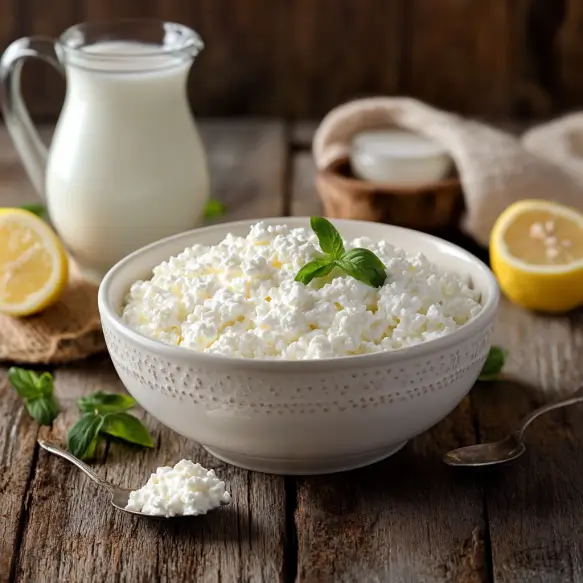Cottage cheese is a staple in many kitchens, known for its high protein content, creamy texture, and versatility. But have you ever wondered what exactly is cottage cheese made of? In this detailed guide, we’ll explore the ingredients, production process, and uses of cheese. Whether you’re new to this fresh cheese or a seasoned fan, you’ll discover everything you need to know.
What is Cottage Cheese?
Cottage cheese is a fresh cheese made from curds. Unlike aged cheeses like cheddar or parmesan, cheese is consumed fresh.
It’s soft, and creamy, and can vary in texture from chunky to smooth. Typically I mix curds with cream, giving it that rich yet light consistency.
Interestingly, cheese has been around for centuries, with its name deriving from the simple practice of making it in cottages with leftover milk. The process remains relatively simple today, making it a favorite among home cheesemakers.
For more insights on dairy products, you can explore the benefits of including dairy in your diet. Additionally, understanding how probiotics in dairy improve gut health can shed light on one of the key benefits of consuming fresh cheeses like cottage cheeses.
Ingredients Used in Cottage Cheese
The primary ingredients in cottage cheese are:
- Milk: Typically I use cow’s milk, though goat or sheep milk can.
- Acid or Rennet: To curdle the milk, you need either an acid (like vinegar or lemon juice) or rennet.
- Cream: Often added to the curds to enhance the texture and taste.
Depending on the brand or recipe, other additives might include:
- Salt
- Stabilizers (like guar gum)
- Probiotic cultures
These simple ingredients create a nutritious product that’s packed with protein and can be low in fat, making it a popular choice for those seeking a healthy diet.
How is Cottage Cheese Made?
1. Fermentation and Curds Formation
The first step in making cottage cheese is adding an acid or live cultures to milk. This starts the fermentation process, which converts lactose into lactic acid, causing the milk to curdle.
2. Separating the Curds and Whey
As the milk curdles, it forms curds (solids) and whey (liquid). The curds are what will become cottage cheeses.
3. Cutting the Curds
I cut The curds into smaller pieces, which determines whether the cheese will be small curd or large curd. The smaller the cut, the smoother the texture.
4. Draining and Creaming
After I’m done with cutting,
I drain the whey, and I leave the curds behind. I rinse The curds and mix them with cream to achieve the desired consistency.
For those interested in making homemade cottage cheese, the process can be simple with just milk, vinegar, and salt.
How Does Cottage Cheese Differ from Other Cheeses?
Cottage cheese is often compared to ricotta, cream cheese, and other fresh cheeses, but they’re not the same. Here’s how it stands out:
- Ricotta: While both are soft and fresh, I make ricotta from the whey left over from other cheese production, whereas I make cottage cheese directly from curds.
- Cream Cheese: Thicker and richer, cream cheese is spreadable and has a higher fat content.
- Feta: Cottage cheese is milder, with a more neutral taste compared to the tangy and salty profile of feta.
Taste and Texture of Cottage Cheese
The taste of cottage cheeses can range from mild to tangy depending on the fat content and culturing process:
- Low-Fat Varieties: Tend to have a tangier taste.
- Full-Fat Varieties: Creamier with a richer, smoother flavor.
The texture can also vary:
- Small Curd: Smoother and often used in recipes like dips and dressings.
- Large Curd: Chunkier and typically enjoyed on its own or with fruits.
How to Use Cottage Cheese in Your Meals
cheese is incredibly versatile:
- Breakfast: Mix it with fruits like berries or bananas.
- Lunch: Use it as a base for salads or in sandwiches.
- Dinner: Incorporate it into baked dishes like lasagna.
- Snacks: Enjoy with crackers or as a dip with vegetables.
You can also blend it into smoothies or use it in baking recipes. For more creative ways to include cheese in your diet, you can check out these delicious cottage cheese recipes that bring out its creamy goodness in unique dishes.
Storing and Freezing Cottage Cheeses
To maximize freshness, store cottage cheeses in the fridge in its original container, tightly sealed. It typically lasts about 7-10 days once opened. For longer storage:
- Freezing: You can freeze cottage cheeses, though the texture might change, making it best for cooked dishes.
FAQs
1. Is Cottage Cheese Healthy?
Yes, it’s a great source of protein and can be low in fat, making it ideal for weight management and muscle growth.
2. Can I Use Cottage Cheese in Place of Ricotta?
Yes, for example, when I cook dishes like lasagna, I use cottage cheeses as a lower-calorie alternative to ricotta.
3. Why Is My Cottage Cheese Watery?
Watery cottage cheeses could be a result of improper storage or the natural separation of whey. Stirring it can help achieve a smoother texture.
Conclusion
Cottage cheese is a nutrient-dense food that’s easy to enjoy in many different ways. Whether you’re looking to boost your protein intake or explore new recipes, it’s a versatile addition to your kitchen.
you can Dive into your next meal with this classic fresh cheese and savor the creamy texture that’s stood the test of time.

